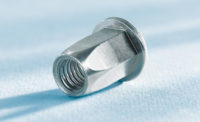During the past few years, technology has revolutionized the process of installing threaded fasteners. With microprocessor-controlled tools, engineers can ensure that every bolt is tightened to the correct torque and angle, that every fastener is installed, and that each fastener is installed in the right sequence.
Until recently, however, that level of control was unavailable for installing blind rivets. Sensors weren't fast enough or small enough to adequately monitor the rivet-setting process, and computing power was lacking. Moreover, blind rivets have simply been a victim of their own success. The fasteners are installed quickly and easily, and their unique design inherently prevents errors.
Nevertheless, many blind fastening applications could benefit from better monitoring of the rivet-setting process. Assemblers would more readily consider using blind rivets if they had some way to confirm that the fasteners were installed correctly, especially in safety-critical applications.
Like any repetitive operation, installing blind rivets is subject to operator error. An operator may not realize that what was thought to be a 5/32-inch rivet is actually a 1/8-inch rivet. One hole with its diameter out of spec, or sheet material of the wrong thickness, may go unnoticed. Riveting tools that alert operators to such problems as they occur can yield substantial savings in rework and reputation, because flaws can be corrected before the assembly moves to the next station or worse, into the field.
This is especially true for safety-critical joints. For example, many automakers qualify attaching a ground wire that supports a vehicle's air bag operation as a critical fastening application. This ground wire is usually attached with a blind rivet. A riveting tool equipped with a process monitoring system allows the assembler to confirm that the rivet attaching the ground wire was set correctly. Moreover, the tool can document, electronically, that the rivet was installed and that all the specifications for the assembly were met.
How it Works
Blind rivets are used to assemble auto parts, aircraft, stoves, air conditioners, garage doors and mailboxes. Bus, truck, appliance and recreational vehicle assemblers are large consumers of blind rivets, and many electronics manufacturers use blind rivets for box-build applications.
A blind rivet is a two-piece fastener that consists of a headed, hollow rivet body and a solid mandrel. The body is tubular with a flange on one end. The tube portion is called the shank, and the flared portion is called the head. The mandrel, or stem, protrudes from the rivet body and looks like a nail. The fasteners come in various materials, diameters, grip ranges and head styles. Material choices include aluminum, steel, stainless steel, copper, Monel and brass.
During assembly, the rivet body is inserted into holes in the parts to be joined. Next, the jaws of a manual, power-operated or automated rivet tool grips the mandrel. As the tool pulls the mandrel into the rivet body, the body expands, forming a head on the opposite, or blind, side of the assembly and clamping the two parts together. At a predetermined setting force or tensile load, the mandrel breaks and falls away.
Pneumatic riveting tools with process monitoring technology are available in both manually fed and automatically fed versions. To monitor the rivet setting process, a small strain gauge mounted in the tool measures the force needed to pull out the mandrel and upset the shank. Variations in this force could indicate that:
- the wrong type or size of rivet was installed.
- the back of the rivet was pulled through the hole.
- the rivet's head separated from its body.
- the holes in the parts were too large.
- the total thickness of the parts to be assembled was too large or too small.
- the jaws on the tool are worn and losing their grip on the mandrel.
Output from the sensor is fed to an external control unit. The control unit monitors each rivet installation in real time and compares the results with learned settings to determine if a quality joint has been made.
Engineers teach the system by setting a series of rivets to establish a base force-time curve, or signature, for a good assembly. Five to 10 rivets are usually enough to generate a workable curve. However, because of manufacturing tolerances, engineers may need to record additional rivet sets to maintain system accuracy. Up to 100 rivet installations can be averaged to create the signature for a particular rivet application.
The curve looks like two humps of a sine wave. Initially, the setting force rises and drops slightly as the mandrel head starts moving and forces its way through the rivet body. Then, the setting force rises and falls sharply as the mandrel head contacts the parts to be joined and breaks off.
Outputs from the control unit can be connected to an audible or visual alarm to alert the operator to "go" or "no go" result. In addition, the control unit can be linked with the PLC governing the assembly line. If a riveting inconsistency is severe enough, the control unit can signal the PLC to shut off air to the tool and stop the line until a supervisor accepts or rejects the assembly in question.
In addition, the control unit maintains aggregate data on the riveting process, and this data can be downloaded to a PC for statistical limited analysis.
Riveting tools with process monitoring technology work with most sizes and styles of blind rivets. However, the technology does not yet lend itself for use with "load-spreading" rivets, because the setting process for these rivets is more difficult to quantify. Instead of collapsing, like most rivets, the body of this rivet splits and folds into three legs, or petals, forming a large, load-bearing surface on the blind side of the assembly.
Besides measuring setting force, the process monitoring system can also count the number of rivets installed at a station. If the assembly requires five rivets, the system won't release the assembly until five rivets have been installed.
Riveting tools with process monitoring are already paying dividends for several automotive suppliers. For example, a manufacturer of automotive seating uses 5/32-inch rivets to attach a center console assembly to a support frame. Though the fasteners work well, the company found that the occasional assembly would contain a rattling rivet. These loose rivets did not effect the performance of the assembly, but rattles are, of course, taboo to automotive OEMs.
Through process monitoring, the company discovered that a 1/8-inch rivet would sporadically find its way into a batch of 5/32-inch rivets. Such a minute difference in size is virtually impossible for a person to detect, but the process monitoring system detected it easily.

